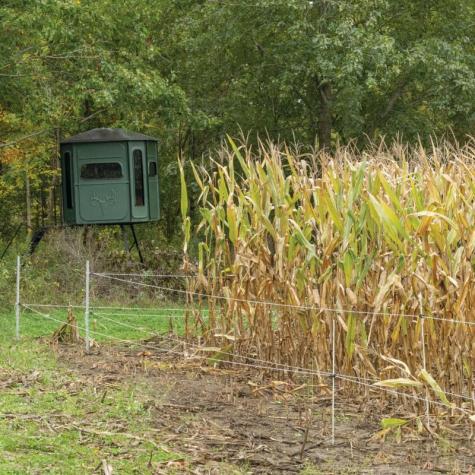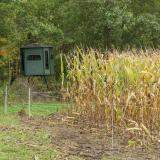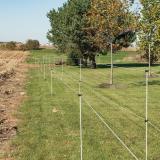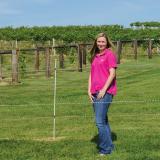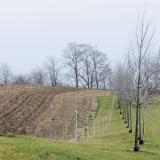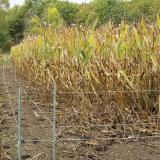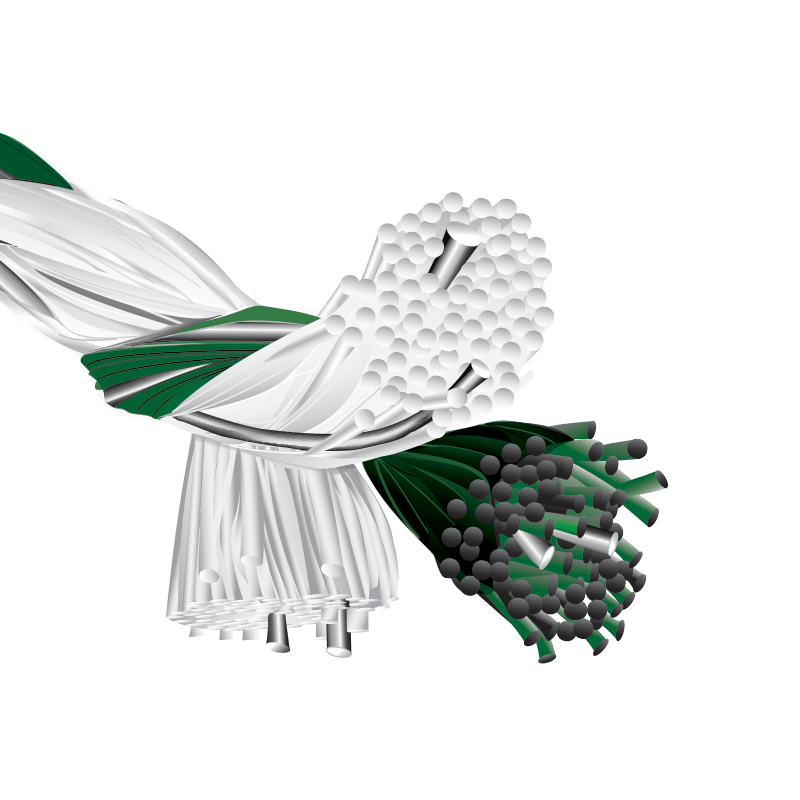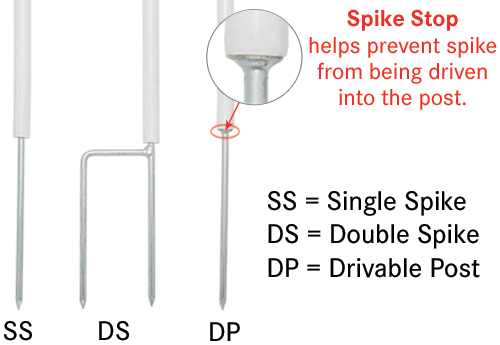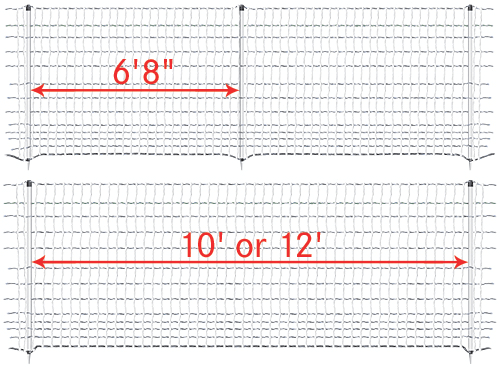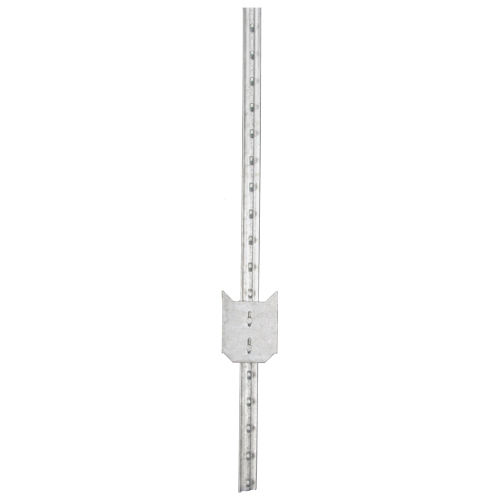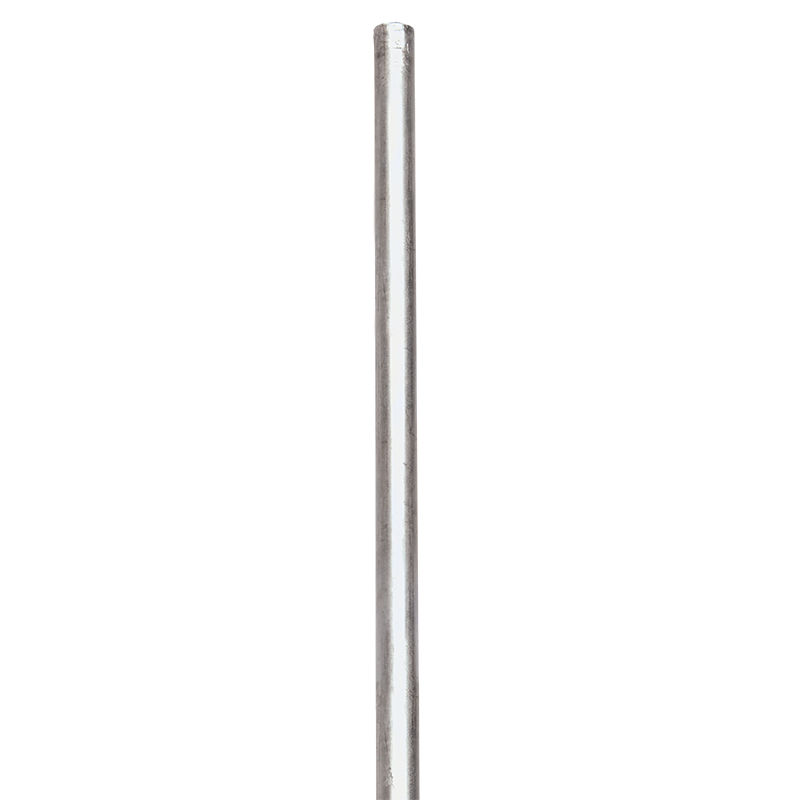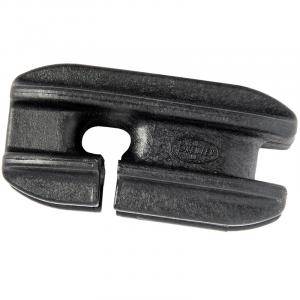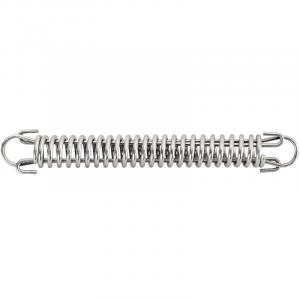3D Anti-Deer Fence (3 to 5 strand)
Instructions/Diagrams
What is a 3D fence?
It’s two fences of electrified rope set 3 ft apart. They combine to make a barrier that has both depth and height—hence 3D. A fence energizer provides the high-voltage, high-energy shock to instill fear in the animal. Scent caps are attached to the electrified rope at intervals to entice deer to first touch the rope with their noses.Electric fences use pain to raise the “cost” (the degree of risk and effort to use an area) and persuade deer that it is safer and less frightening to feed, rub or trail elsewhere.
How does a 3D fence work?
Deer experience “landing anxiety” before they decide to jump over something. So, when facing a fence that has height, length and depth, deer are more tentative than with a fence that’s only “2D” (tall and wide, but not deep).Experts tell us the depth perception of species with side-of-the-head eye placement (deer, horses) is less than for species with both eyes in front (cattle, humans).
When a deer encounters a 3D fence, they are more likely to approach it cautiously. They will check it with their sensitive noses and receive a memorable electric shock. The pain encourages deer to find a less risky “restaurant,” trail or bedding ground.
Is it foolproof?
No. The only 100% deer barrier is a solid wall at least 8 ft tall! A desperate animal may risk the pain—which is why you can’t keep out starving deer with electric fencing if the site is their only food source.It’s been our experience that electric fences for deer fail because:
- Installed at the wrong time (after the herd’s habit is ingrained).
- Managed without an awareness of how a deer herd interacts with fences.
Key components you’ll need:
- ✔ Rope Conductors
- Conductors that are 4.5mm and 6.0mm in diameter are best. They last longer in semi-permanent and permanent situations. Black and white is the most visible to humans and fast moving deer (slow ones too). Weed growth under electrified ropes needs to be removed or sprayed once each summer.
- ✔ Posts
- Use strong wood or metal posts for corners. Their stiffness withstand strain over long periods to keep conductors tight. For semi-permanent installations, fiberglass rods make excellent line posts between corners and are less $$ than wood or steel.
- ✔ Insulators
- Match insulators to the type of posts you’re using. UV-resistant black insulators are best for long-term use, followed by white. Avoid yellow or untreated insulators; they breakdown quickly in harsh sunlight.
- ✔ Energizer
- Modern fence energizers send very brief (less than 3/10,000 of a second), high-voltage pulses through a conductor every 1–2 seconds. Choose a unit powerful enough to create a memorable shock.
- ✔ Scent caps
- Should be refilled with apple scent before a season of high deer activity (and ideally every 10 days during the high-activity seasons). When are those seasons? For rubbing damage it’s in the autumn before the rut. For browsing damage it depends on plant species.
FREE shipping on qualified orders over $100!
We offer many fences to fit your situation, including different heights and lengths, multiple colors, drivable posts and positive/negative options for dry soils. Questions? Call our fence consultants at
-
Conductors - Rope-Twine-Wire-Tape
EnduraSoft® 6.0, 660 ft roll
Item #256500 -Highly visible polyester electric fence conductor with excellent conductivity over long distances. 6mm (1/4") diameter. 25 years probable life.
$98.00 -
Conductors - Rope-Twine-Wire-Tape
EnduraSoft® 6.0, 1320 ft roll
Item #256600 -Highly visible polyester electric fence conductor with excellent conductivity over long distances. 6mm (1/4") diameter. 25 years probable life.
$196.00 -
Conductors - Rope-Twine-Wire-Tape
IntelliRope® PE 6.0, 1320 ft. roll
Item #256910 -6mm (1/4") dia. electrifiable rope for permanent or temporary fences. Polyethylene filaments resist wear and abrasion. An effective anti-deer conductor.
$118.00 -
Conductors - Rope-Twine-Wire-Tape
IntelliRope® PE 6.0, 660 ft. roll
Item #256900 -6mm (1/4") dia. electrifiable rope for permanent or temporary fences. Polyethylene filaments resist wear and abrasion. An effective anti-deer conductor.
$59.00 -
Conductors - Rope-Twine-Wire-Tape
IntelliRope® PE 4.5, 660 ft roll
Item #245100 -4.5mm (3/16") electrifiable rope for permanent or rotational grazing fences. Tinned copper filaments for high conductivity (50 Ω per 1000 ft).
$40.00 -
Conductors - Rope-Twine-Wire-Tape
IntelliRope® PE 4.5, 1320 ft roll
Item #245200 -4.5mm (3/16") electrifiable rope for permanent or rotational grazing fences. Tinned copper filaments for high conductivity (50 Ω per 1000 ft).
$80.00 -
Conductors - Rope-Twine-Wire-Tape
IntelliBraid®, 660 ft. roll
Item #256710 -6mm (1/4") dia. braided rope conductor for electric fences. Black/white color is easy for humans and livestock to see. Polyester for high UV-resistance.
$113.00 -
Conductors - Rope-Twine-Wire-Tape
IntelliBraid®, 1320 ft. roll
Item #256730 -6mm (1/4") dia. braided rope conductor for electric fences. Black/white color is easy for humans and livestock to see. Polyester for high UV-resistance.
$226.00
-
Energizer Kits
SolarStop™ 80 Fence Energizer Kit
Item #113610 -Solar powered 0.8 output joule energizer for electric fences. Used to contain sheep, goats, poultry, swine, cattle and horses. Effective against predators.
$304.00 -
Energizer Solar Panels and Accessories
4 joule DIY Solar Energizer Kit, 50 watt panel
Item #113004 -Build your own 4- or 8-joule solar-powered electric fence charger. Kit includes all the components to energize livestock fences without access to 110V power.
$721.00 -
Energizer Kits
PrimaShock® 8 Energizer
Item #113101 -8 joule output dual-power (AC/DC) fence energizer. Provides ample power for your ranch or large grazing operation.
$198.00
-
Posts and Accessories
SmoothCote™ FiberRod Posts, 4 ft (3/8" dia), each
Item #321841 -Lightweight fiberglass posts for use with livestock containment fence or deer deterrent fence.
$2.10 -
Posts and Accessories
SmoothCote™ FiberRod Posts, 5 ft (3/8" dia), each
Item #321851 -Lightweight fiberglass posts for use with livestock containment fence or deer deterrent fence.
$2.60 -
Handling Equipment
Galvanized Steel T Post, 6 ft
Item #327600 -Thick galvanized coating protects posts from the elements. Excellent supports for portable, permanent and high-tensile fence systems.
$24.50
-
Fence Connectors and Accessories
Scent Caps
Item #256300 -Conductive metal caps that when scented, attract deer and other wildlife to a fence. Animals test the fence and learn to stay away.
$0.75 -
Fence Connectors and Accessories
Apple Scent, 4 oz bottle
Item #256404 -Apply to scent caps to encourage deer to test (and later avoid) electric fences around gardens, sweet corn patches and orchards.
$6.90 -
Fence Connectors and Accessories
Ground Rod, Galvanized, 6'
Item #151000 -Complete the circuit of your electric fence with galvanized grounds. No corrosion unlike copper rods.
$22.00 -
Fence Connectors and Accessories
Stainless Steel Clamp
Item #151800 -Stainless steel hose clamp. Firmly holds negative leads from the energizer to the ground rod.
$1.30 -
Insulators
PI 21n Notched Terminal Insulator, each
Item #369200 -For insulating low-tension electric fences at corner and end posts and around trees.
$1.25 -
Insulators
ScrewOn Rope/Tape Insulator, each
Item #325400 -For holding rope, twine and narrow tape onto portable electric fence posts.
$0.50 -
Insulators
Rotating Corner Post Insulator, each
Item #380900 -Allows rope, twine, tape and cable to flow around corners and curves when tension changes occur (due to ice, snow and impacts).
$1.25 -
Insulators
TuffRing II Insulator (white), each
Item #380705 -Screw-in ring insulator for corners and starting (or ending) a low-tension fence line on a wooden post.
$0.95 -
Insulators
SnapOn Harp Clip, 3/8", each
Item #325310 -For attaching conductors at desired height on 3/8" fiberglass posts. Design allows conductors in but prevents their escape.
$0.40 -
Insulators
3/8" PowerGrip Clip, each
Item #325000 -Simple spring metal clip that hold electric fence conductors. Use with 3/8", 1/2" and 11/16" insulated fence posts.
$0.25 -
Insulators
PI 21 Terminal Insulator, each
Item #369100 -Reliable electric fence insulator for wood/steel posts and trees at the ends, corners or curves of semi-permanent and temporary fences.
$0.75 -
Fence Connectors and Accessories
P Spring
Item #255010 -Used to keep rope fences at desired tension. Install a P Spring every 1320 ft.
$3.50 -
Fence Connectors and Accessories
PowerLink™ 4.0, 48" long
Item #335505 -Make instant, in-field connections between electric fences without turning off the energizer. Simple to use and effective.
$5.50 -
Fence Connectors and Accessories
Rope Connector 1.0
Item #256200 -An effective electrical connection for 6mm (1/4") electric fence rope conductors.
$2.75 -
Fence Connectors and Accessories
Rope-To-Rope Link
Item #335610 -Use this Rope-To-Rope Link to make a rapid connections between 6mm electrified rope lines on permanent fences.
$6.50 -
Fence Connectors and Accessories
RopeLink 2.6 (for 6mm rope)
Item #256210 -For splicing or terminating 4.5mm and 6.0mm fence conductors. A fast, yet secure connection.
$0.85 -
Fence Connectors and Accessories
BlitzLight™
Item #132300 -Flashes with every pulse over 3000V (the opposite of the Volt Alarm). For energizers 0.5 joule or larger.
$45.00 -
Fencing
Warning Sign
Item #346000 -Let passersby know that your fences are electrified with this easy-to-read electric fence warning sign.
$2.50 -
Fence Connectors and Accessories
Fence & Battery Digital Tester
Item #200010 -All-in-one fence tester checks the voltage of energizers, fences and 12V batteries. Simplify electric fence troubleshooting with one device!
$38.00
Precautions
Electric fence is a pain barrier, not a physical barrier. A common mistake is not electrifying it. Animals may escape or become entangled (and may die). On a % basis, entanglement is very rare, but it can and does occur. If animals are scared or starved it will not keep them in. The first time you put the animals in the net, you should be available to watch them for a while. That way if one were to get into the fence and get caught, you can turn the power off and get them loose.
Warning! Due to risk of fire, do NOT use continuous output energizers with electric netting or electro-plastic conductors such as rope, twine or tape. Use only with a low or wide impedance intermittent pulse energizer. (Fi-Shock™ brand energizers which are sold as low impedance, continuous current output should NOT be used with electric netting.) All energizers sold on Premier’s website use an intermittent pulse and are suitable for use with electric netting.
Dry conditions and wintertime usage may reduce the effectiveness of electric fencing. Ice and heavy snow can flatten netting and thereby damage it.
Dry or frozen ground may cause post spikes to bend or break if inserted with force. Pilot holes may be needed. We recommend using drivable or single spike posts in hard soils. Double spike posts provide more stability when the ground is soft.


